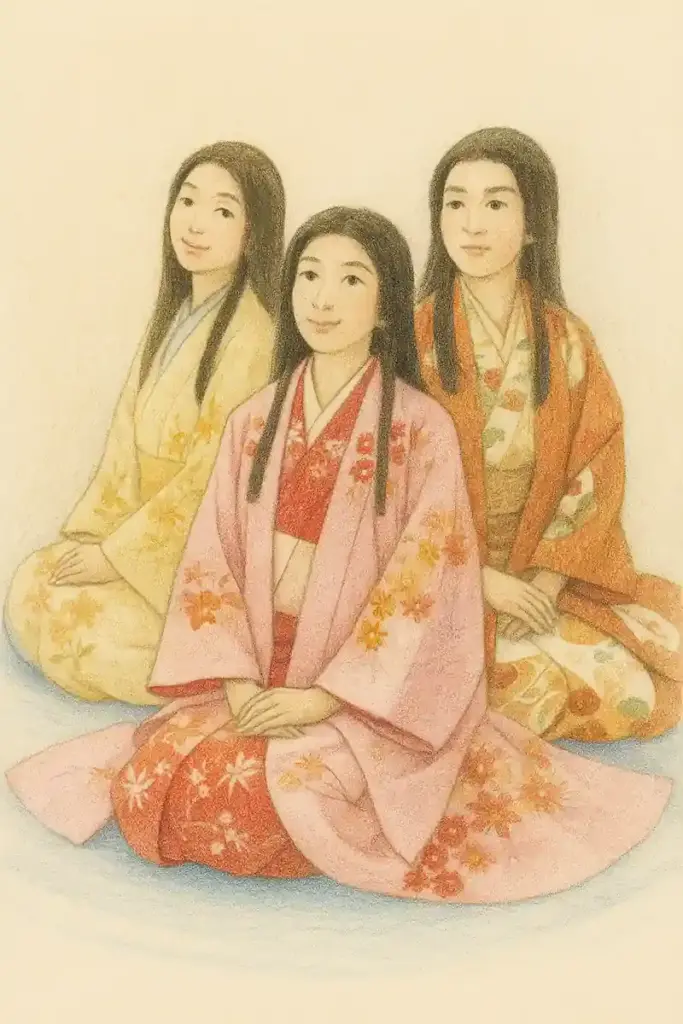
A Single Flower of Resolve in an Era of Chaos
Gō’s vision of “family” and “peace” through the lens of a war-torn era
The NHK historical drama Gō: Hime-tachi no Sengoku (Gō: The Sengoku Princesses) tells the story of Japan’s tumultuous Warring States period through the eyes of one remarkable woman. Gō, the youngest daughter of Oichi (sister to Oda Nobunaga) and warlord Azai Nagamasa, was born into a powerful yet perilous lineage. Despite enduring deep personal loss and political turmoil, she ultimately became a foundational figure in the Tokugawa shogunate, helping usher in an era of peace.
What stood out in this drama is that Gō wasn’t merely a figure in the shadow of great men—Nobunaga, Hideyoshi, and Ieyasu. She interacted with each of them in ways that reveal her unique perspective at the heart of Japan’s transformation. Reframing history through her eyes uncovers a more intimate, human side of events often dominated by male warlords, allowing us to feel the emotional temperature of an age long past.
Gō’s life mirrors the very essence of the Sengoku era. Her father, Nagamasa, took his own life after losing a battle to Nobunaga. Gō grew up never knowing him. Later, her mother, Oichi, remarried Shibata Katsuie, only to be driven to suicide as Toyotomi Hideyoshi rose to power. Thus, young Gō lost a father figure twice over, both times to the fires of political ambition.
Though the Toyotomi clan took Gō and her sisters under their protection, to Gō, Hideyoshi was also the man who had torn her family apart. Amid the flames of burning castles and the heartbreak of separation, she began to question: What truly defines a family? Why must it be torn from us? These questions became the inner fire that guided her throughout her life.
Gō was also repeatedly caught in the web of political marriage. First to Saji Kazunari, then to Toyotomi Hidetsugu, and finally to Tokugawa Hidetada, heir to Ieyasu and the second shogun. Although treated as a pawn in dynastic strategies, Gō gradually found her voice, evolving into a woman who made her own choices and stood by them.
Eventually, the final clash between the Toyotomi and Tokugawa clans—the Siege of Osaka—claimed the lives of Gō’s sister Chacha (Yodo-dono) and her nephew Hideyori. Gō was forced to confront the heartbreak of family turning against family. Yet even amid grief, she resolved to be part of the peace that would close the chapter on centuries of warfare.
One poignant scene in the drama shows Tokugawa Ieyasu on his deathbed, quietly watching as Gō and Hidetada share a peaceful conversation. Whether historically accurate or not, the scene conveys Ieyasu’s deep sense of relief—his trust that the future was in capable hands. For the viewer, it’s a powerful moment that encapsulates the emotional gravity of a generation forged in conflict.
This essay is divided into three chapters, each tracing a part of Gō’s journey—how she lived as a human being, and how she engaged with the forces of history. Even amid betrayal, strategy, and loss, her unwavering hope for “family” and “peace” continues to offer profound insight to those of us living in the modern world.
Chapter One: Young Gō Amid the Flames — From the Azai to the Shibata Clan, the Start of a Fateful Journey

As the youngest of the three Azai sisters, Gō was born into the chaos of the Sengoku period with a destiny marked by relentless twists of fate. Her father was Azai Nagamasa, lord of Odani Castle in Ōmi Province, and her mother, Oichi, was the sister of Oda Nobunaga. Though she came from noble blood, Gō’s life was steeped in turmoil from the very moment of her birth.
In 1573, the same year Gō was born, Odani Castle was besieged and destroyed by Nobunaga’s forces. Her father, Nagamasa, took his own life. Although the Azai and Oda clans had once been allies, Nagamasa secretly allied with Nobunaga’s enemies, the Asakura clan, betraying him. Enraged, Nobunaga launched a merciless campaign against the Azai-Asakura alliance, eventually leading to Odani’s fall.
Gō, still an infant, grew up never knowing her father’s face or voice. This early and absolute absence of a father figure cast a quiet but lasting shadow over her heart, shaping how she would later experience both paternal love and loss again and again.
By Nobunaga’s command, Oichi and her three daughters were spared and placed under the Oda clan’s protection. But blood ties offered no true guarantee of safety. Following Nobunaga’s death in the Incident at Honnō-ji, Oichi married Shibata Katsuie, one of Nobunaga’s most loyal generals, and the family moved to Kitanoshō Castle.
Katsuie is often portrayed as a brave yet warm-hearted man, and he treated the sisters with genuine affection—as if they were his own daughters. For Gō, he became something precious: a second father. In his presence, she enjoyed a brief, peaceful chapter in her young life. Initially wary, Gō gradually opened her heart to him, drawn in by his kindness.
But fate would not grant them peace for long. In 1583, a brutal power struggle erupted in the wake of Nobunaga’s death. Katsuie clashed with Toyotomi (formerly Hashiba) Hideyoshi in the Battle of Shizugatake. Katsuie was defeated and, along with Oichi, took his own life in Kitanoshō Castle. This marked the second time Gō lost a father figure—a traumatic echo of the past that left her with a profound sense of helplessness, as if she had once again failed to protect those she held dear.
Adding to the irony, the man responsible for Katsuie and Oichi’s deaths was none other than Hideyoshi—the same commander who had once brought down Odani Castle. Yet it was also Hideyoshi who would, once more, take Gō and her sisters under his protection.
It’s not hard to imagine the emotional complexity this created for Gō. Though the gesture was cloaked in the noble ideal of “protecting the daughters of the Oda lineage,” for Gō it must have felt like a bitter pill—being entrusted to the very man who had shattered her family. It was a tangle of humiliation, confusion, and unresolved grief.
The drama captures this trauma vividly through a harrowing scene: the castle engulfed in flames, the sisters scattered in panic, unable to save their family or themselves. The chaos and despair reflected in young Gō’s eyes offer a jarring contrast to the peace we often take for granted today.
As I watched that scene, I couldn’t help but connect it to moments in my own life when I had to say goodbye to someone I loved. Our world is different now, but the fundamental human pain of losing someone precious against your will—that transcends time.
And just as striking during this period is the bond between the sisters. Chacha, Hatsu, and Gō supported one another through fire and fear. Sometimes they clashed, sometimes they consoled—but always, they remained connected. Their relationship wasn’t just about blood—it was about survival, shared trauma, and silent strength. In that, they were comrades as much as sisters.
In Chapter One, we see through Gō’s eyes the injustice of her era, and the quiet yet fierce resilience of the women who lived it. Her innocent wish “to protect her family” becomes the seed of an unwavering resolve—one that only grows stronger in the face of coming trials.
Chapter Two: A Will Forged in Strategy — Trials and Lessons in the Toyotomi Household
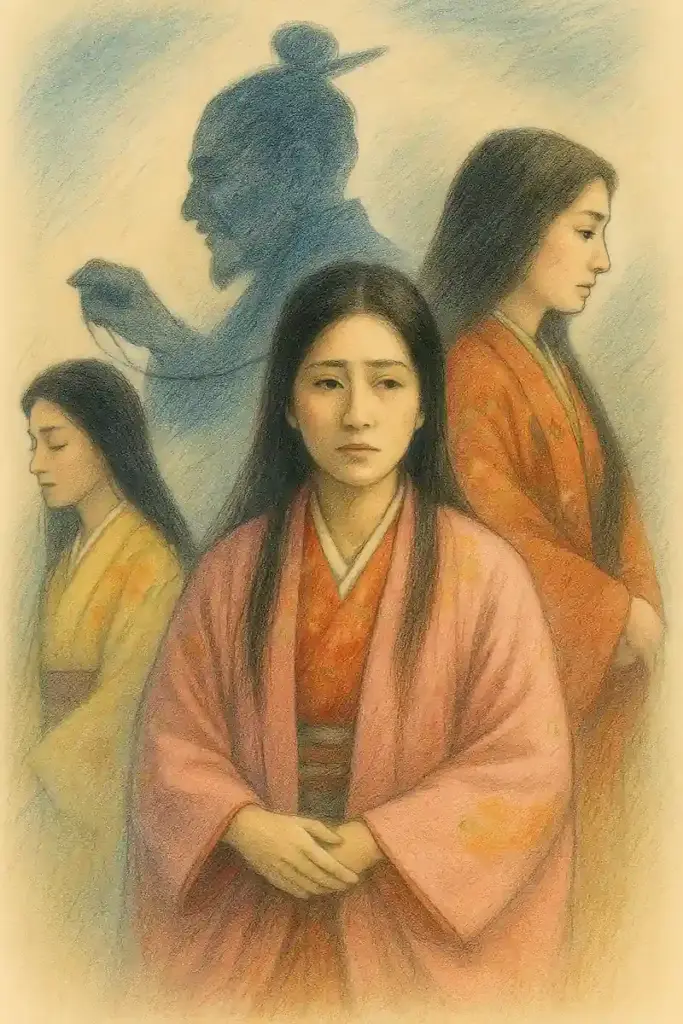
After the deaths of their mother Oichi and stepfather Shibata Katsuie, Gō and her sisters once again came under the guardianship of Toyotomi Hideyoshi. For young Gō, his presence was deeply unsettling. On the surface, she was treated with respect as a princess of the Oda lineage. But to her, Hideyoshi was the man responsible for attacking Odani Castle, driving her father to death, and later, for the fall of Kitanoshō that claimed her stepfather and mother.
“Once again, he’s the one who took my family away.” Gō may have been too young to articulate such thoughts at the time, but a quiet fire had already begun to burn deep within her.
Hideyoshi began treating the three sisters not just as wards, but as strategic assets. His interest in Chacha, the eldest, was especially intense—bordering on obsession. She became his concubine and later bore his son, Hideyori, placing her firmly at the center of Toyotomi power. Watching her sister’s ascent from close by, Gō couldn’t help but be stirred by complex emotions.
“Did my sister truly choose this path?” “What purpose does our existence serve?”
Gō, too, became a pawn in Hideyoshi’s political schemes. Her first marriage was to Saji Kazunari, a minor lord from Owari, but it was quickly annulled by Hideyoshi’s order. A second match was arranged with Hideyoshi’s own nephew, Hidetsugu, but he died during the Korean campaign—leaving Gō once more disillusioned by the fleeting nature of alliances dressed as marriage.
Yet through each failed union and forced alliance, Gō’s inner resolve quietly grew. She began to form a belief that life should not be passively inherited, but actively chosen. She wanted to think for herself, to make her own path—not just follow one laid out for her by others.
Amidst the constant cycle of expectation and disappointment, rise and ruin, Gō endured—and she learned. In an age where obedience was a woman’s highest virtue, she developed the clarity to see through the fog of politics and the courage to speak when needed. The drama portrays this growth with quiet depth, leaving a lasting impression on the viewer.
Gō’s relationship with Hideyoshi also began to shift. Though she never fully trusted him, she found herself resonating—if only slightly—with his vision of a world without war. Having lost so much to conflict, the idea of lasting peace was no longer a dream to her—it was a necessity, something tangible she longed to help create.
In Hideyoshi’s final years, the regime began to wobble. With Hideyori’s birth, succession tensions intensified, and divisions grew among his retainers. It was during this time that a new force emerged: Tokugawa Ieyasu. To Gō, Ieyasu wasn’t exactly a sworn enemy—but like Hideyoshi, he represented yet another upheaval, another wave of change threatening to remake the world around her.
The era was undeniably shifting. Once merely a player in other people’s games, Gō now found herself at a crossroads—called upon to make her own choices and to envision what kind of world she wanted to help shape.
Chapter Two traces how Gō’s childhood innocence matured into a sense of purpose, shaped by hardship and heartbreak. From someone who needed protection, she began to transform into someone ready to protect others. And so begins the next chapter of her life—her emergence as “Mother of the Tokugawa.”
Chapter Three: With Love and Pride — Gō’s Final Years as Mother of the Tokugawa
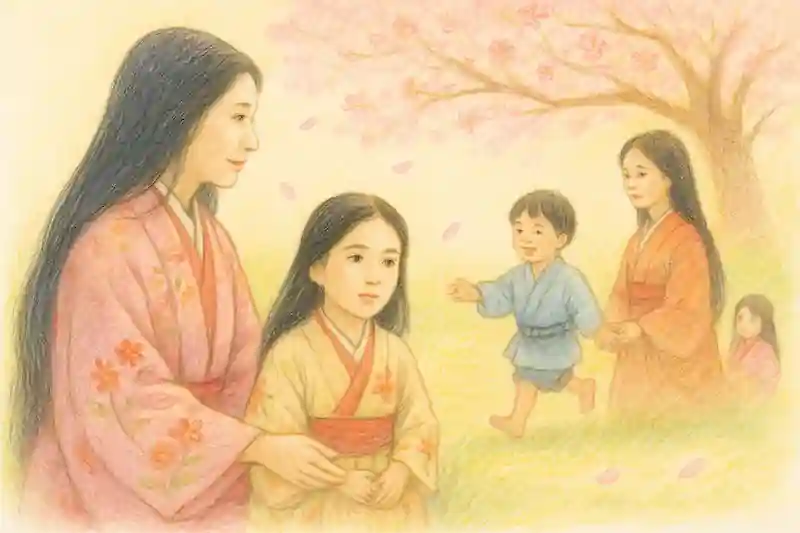
After years of being buffeted by political machinations, Gō’s life took a new turn with her third marriage. As Hideyoshi’s adopted daughter, she was wed—once again for strategic reasons—to Tokugawa Hidetada, heir to Tokugawa Ieyasu. Following their marriage, Gō moved to Edo Castle, where she began a new chapter of her life at the heart of the emerging Tokugawa shogunate.
For someone like Gō, who had already endured the heartbreak of political marriages, this too felt like an unavoidable fate. Yet Hidetada, unlike his father Ieyasu, was not defined by stoic strength but by a quiet kindness and calm disposition. Though Gō initially kept her guard up, she gradually came to trust him, and in time, they built a relationship grounded in mutual respect.
Together they had many children, but none were as significant to Gō as their son Iemitsu—who would go on to become the third shogun—and their daughter Masako, who would become Empress Consort to Emperor Go-Mizunoo. These children were her pride and joy, the living embodiment of hope after a lifetime of loss. For Gō, who had spent so much of her life losing loved ones to war and politics, this time—raising and protecting her own family—must have been her most precious chapter.
But peace remained fragile. Tensions with the Toyotomi grew once again. When her sister Chacha (Yodo-dono) and her son Hideyori rose in defense of the Toyotomi legacy, Gō was forced to confront a heartbreaking truth: family would soon face family on the battlefield—made all the more painful by the fact that Hideyori’s wife was none other than Gō’s own daughter, Senhime.
Gō tried desperately to prevent war, but the tide of history could not be held back. Her husband Hidetada, despite knowing his wife’s blood ties to Yodo-dono and Hideyori, had to make a painful decision as head of the Tokugawa: to proceed with the Siege of Osaka for the sake of national unification and peace.
Hidetada’s decision carried the weight of Ieyasu’s vision, and even that of Nobunaga before him: to build a world without war. Amid the fierce struggle between Toyotomi and Tokugawa, these men were not simply driven by ambition—but by a vision for the future. And to bring that vision to life, someone had to make the unbearable choices.
When Osaka Castle was engulfed in flames and both Chacha and Hideyori perished, Gō faced the loss of her sister with silent resolve. Rather than weep endlessly, she transformed her grief into a renewed vow—to protect the peace they had all sacrificed so much to achieve.Her daughter Senhime was safely rescued from the burning castle and later began a new chapter of her life at Himeji Castle, where she married Honda Tadatoki.
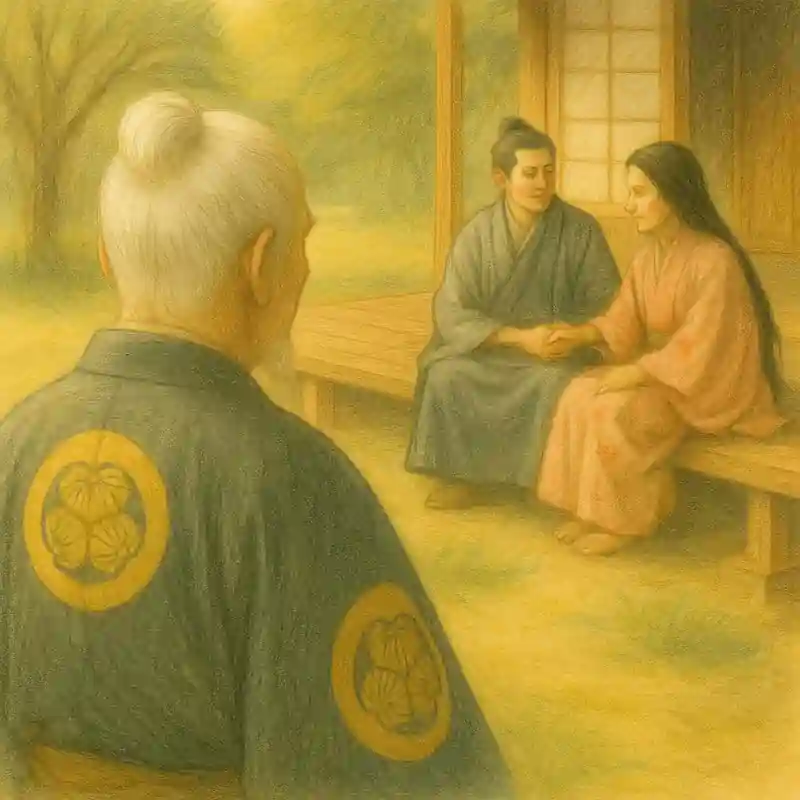
In the drama’s poignant final scenes, Tokugawa Ieyasu lies ill, nearing the end of his long life. He quietly watches as Gō and Hidetada speak together peacefully—reassured that the legacy he fought for is in good hands. As he closes his eyes and takes his final breath, it feels as though he’s telling himself: “It was all worth it.”
Though not confirmed by historical record, the emotional truth of that moment rings deeply. Ieyasu, who once served as a hostage and made countless weighty decisions throughout his life, finally finds peace in the knowledge that he can now pass the torch. Watching that, I too felt my heart swell with emotion.
After Ieyasu’s death, Gō continued to serve as a prominent presence in the shogunate—not only as a wife and mother, but also as a stabilizing figure in politics and courtly life. The girl who once had no agency in a world ruled by men had become a guiding force for an age of peace.
In her later years, Gō looked upon her grandchildren with quiet joy, carrying within her the memories of childhood trauma, the warmth of the Shibata household, the splendor and sorrow of the Toyotomi, and the steadiness of the Tokugawa era. Each chapter of her life, in its own way, was cherished and meaningful.
In the final scene of the drama, Gō and Hidetada exchange a glance and smile. In that brief moment lies a lifetime: the pain of loss, the burden of survival, and at last, the quiet happiness they had earned. And in the distance, the laughter of children growing up in a world free from war. The future Gō had dreamed of and fought for was finally taking root.
Afterword: What Gō Teaches Us Across the Centuries
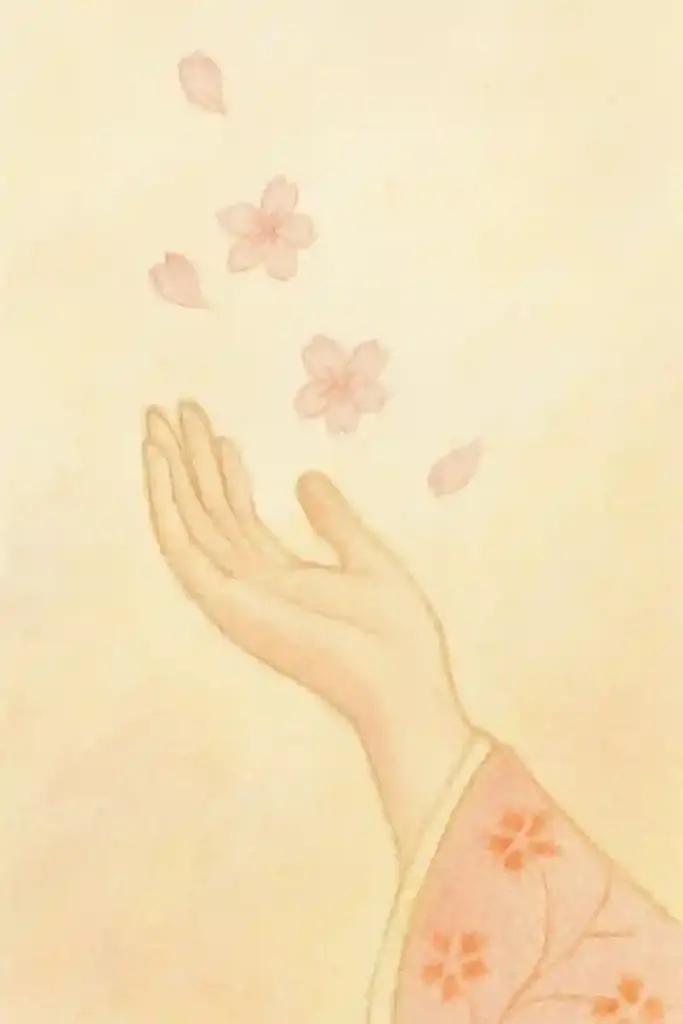
Gō’s life shines all the more vividly because it was forged in the crucible of the Warring States period—a time of turmoil, cruelty, and unrelenting change. Though used repeatedly as a tool for political gain, she never lost sight of who she was.
Time and again, she lost her family. And each time, she asked herself, “Why must this happen?” Yet she never gave in to despair. She carried the memory of her sister with her, overcame even the grief of her death, and continued to live for a future without war—for the sake of generations yet to come. That quiet strength lingers longer in the heart than any victory won by power alone.
The drama Gō: Hime-tachi no Sengoku is more than a historical reenactment. It is, above all, a testament to a woman who truly lived—even as history tried to write her out.
We in the modern world live within a peace we often take for granted. But stories like Gō’s—of someone who resisted fate to protect what mattered most—remind us just how fragile and precious that peace truly is. And that it is something worth safeguarding.
Her life was a cycle of loss and renewal. Yet every painful chapter brought her closer to becoming “Mother of the Tokugawa,” a woman whose influence helped lay the foundation for an enduring peace.
Looking back on her journey, one truth stands out above all— Live your life by your own will. No matter how difficult that may be, even when others try to use you, Gō’s story reminds us that we can hold fast to our dreams. And in doing so, we find courage we didn’t know we had.
Times may change, but the human heart remains the same. And so, Gō’s story will continue to live on—quietly, powerfully—within all of us.
How to Watch the Taiga Drama “Gō: Hime-tachi no Sengoku”
- Amazon Prime Video (via FOD): https://amzn.to/3SZJ8uj
- Amazon Prime Video (via NHK On Demand): https://amzn.to/3I6lkT4
- Purchase on Blu-ray: https://amzn.to/4lod67v
⚠️ Please note: English subtitles or dubbing are currently not available for this series, either via streaming or physical media.
This lack of accessibility may be one reason why Gō remains relatively unknown outside Japan — yet it is a story that truly deserves global recognition. We hope NHK will consider releasing an English-subtitled version in the future.
※ This page contains affiliate links.

comment